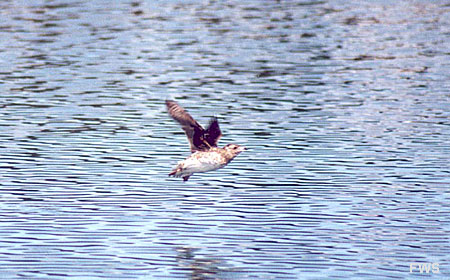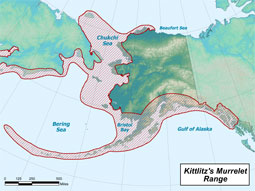Kittlitz's Murrelet
(Brachyramphus brevirostris)
Printer Friendly
Did You Know?
Kittlitz’s murrelets do not nest in colonies unlike 98% of other seabirds.
General Description
The Kittlitz’s murrelet is a small, stocky seabird with a relatively large head and short bill and tail. There are no known measureable differences in appearance between females and males. Its summer plumage is variable consisting of a light, off-white underside, with brown, gray, and reddish-gold feathers on its back, wings, and head. Its eye appears dark and relatively large, and is thought to aid in foraging in turbid waters. The Kittlitz’s murrelet has a very different winter plumage with white underside, throat, and face, with black or dark gray back, wings, cap, and sometimes a distinct black necklace. In flight the Kittlitz’s murrelet appears small and fast with very rapid wing beats; it usually flies low to the water.
Similar Species
The Kittlitz’s murrelet can be confused with the marbled murrelet, a species similar in size and plumage. Distinguishing features of the Kittlitz’s murrelet are white outer tail feathers, white above the eye in winter plumage, a shorter bill, and often a white trailing edge of the secondary wing feathers.
Life History
Growth and Reproduction
There is not a lot of information on the breeding and reproduction of Kittlitz’s murrelet. They nest on steep unvegetated mountainsides or slopes above the timberline near glaciers and cirques. It is thought that they are monogamous and lay one egg in June. The eggs hatch in July, and the young fledge in August. They nest in solitary pairs in low densities and may exhibit site fidelity for their nesting grounds.
Feeding Ecology
Kittlitz’s murrelets capture their prey underwater by diving. They generally forage in turbid cold waters. Their diet is largely fish, euphasiids, amphipods, and small crustaceans. Key or important prey species include Pacific sandlance, Pacific herring, capelin, and Pacific sandfish.
Migration
Researchers do not clearly understand where Kittlitz’s murrelets spend the winter months. During the summer they move into nearshore waters, such as Prince William Sound, Glacier Bay, and the Aleutian Islands, and breed on exposed slopes above the ocean. They are consistently present in these summer habitats from June-August, but then disappear in early fall and through the winter, presumably to offshore marine habitats. Populations in the Bering and Chukchi Seas are believed to move south to stay ahead of the advancing pack ice.
Range and Habitat
During the summer breeding season Kittlitz’s murrelets are scattered throughout the coastal marine waters of Alaska and Russia ranging from Southeast Alaska to the Beaufort and Chukchi Seas, through the Aleutian Islands to the Sea of Okhotsk. Their breeding habitat is rocky treeless slopes and mountains, often associated with glaciers. Kittlitz’s murrelets forage during the summer months in the cold nearshore marine waters of their breeding areas.
Not much is known about the winter range and habitat preferences of Kittlitz’s murrelets. It is likely that the birds move offshore in Russia and Alaska during the winter months and seek out locations with abundant pelagic forage fish and zooplankton.
Status, Trends, and Threats
Status
The current abundance of Kittlitz’s murrelets is not accurately known for most of its range.
NatureServe:
Global – G2 (imperiled)
State – S2B, S2N (imperiled, both breeding and nonbreeding populations)
IUCN: Critically Endangered
Endangered Species Act: Candidate
Trends
The U.S. Fish and Wildlife Service determined that this species should be listed as threatened or endangered under the Endangered Species Act, but due to a lack of time and funds, designated the Kittlitz’s murrelet as a Candidate for listing. The basis for this ESA listing decision were reported declines of 38-84% in major population centers, including Prince William Sound, Glacier Bay, and Kenai Fjords. Recent studies suggest a stabilization of population numbers.
Threats
Possible threats to the Kittlitz’s murrelet include a decrease in prey availability, climate change, bycatch in fisheries, and oil spill contamination. There is some concern that this species may be competing with commercial fisheries for some of their prey species. There also may be changes in prey abundance or distribution due to climate change. Climate change may also impact their nesting habitat in positive or negative ways. Kittlitz’s murrelets are generally associated with glacially-fed or other turbid waters, which may change with receding glaciers and altered water flows. Kittlitz’s murrelets are also taken as bycatch in gillnet fisheries due to their foraging style which includes underwater wing pursuit of small fish. The magnitude of this threat is not well understood. This species is susceptible to marine-based oil spills since it spends significant time on the water’s surface.
Fast Facts
-
Size
Small -
Lifespan
Unknown -
Distribution
Coastal Alaska from Point Lay to Southeast Alaska and the Russian far east -
Diet
Fish, euphasiids, amphipods, and small crustaceans -
Reproduction
Monogamous, solitary nesting, one egg at a time
Did You Know?
- Kittlitz’s murrelets do not nest in colonies unlike 98% of other seabirds.
- Kittlitz’s murrelet is one of the rarest seabirds in North America.
- Kittlitz’s murrelets were significantly impacted by the Exxon Valdez oil spill in 1989.
- Kittlitz’s murrelets are very secretive nesters that use camouflage to avoid nest detection.
- Murrelets molt in the fall and are flightless for 6 weeks as they grow new feathers.
- Kittlitz’s murrelets have been nicknamed the “Glacier Murrelet” due to the frequent association with glaciers.
- Kittlitz’s murrelets were named for Heinrich von Kittlitz, the German zoologist who first collected this species in the 1820s.
Uses
Kittlitz’s murrelets are not thought to have been an important species for subsistence use in Alaska. Currently, Kittlitz’s murrelets are commonly sought by birdwatchers.
Management
The Kittlitz’s Murrelet is currently listed as a Candidate species under the Endangered Species Act and protected by the Migratory Bird Treaty Act which are implemented by the U.S. Fish and Wildlife Service. As a sovereign entity, the State of Alaska retains trust responsibilities over this species and is actively engaged in the management, conservation, and regulation of the Kittlitz’s Murrelet and its habitat.
Research
The Alaska Department of Fish and Game has supported and led several recent and ongoing Kittlitz’s murrelet research projects.
- In 2003–2006 Fish and Game funded a study to determine potential causes of the reported decline in Kittlitz’s murrelet in Glacier Bay. A M.Sc. these was published detailing the effects and impacts of vessel activity on Kittlitz’s murrelet in Glacier Bay (see thesis (PDF 420 kB)).
- In 2004–2007 the U.S. Fish and Wildlife Service conducted surveys of Kittlitz’s and marbled murrelets in Kachemak Bay with funding from Fish and Game. See the final report (PDF 3,627 kB) submitted to Fish and Game for more information.
- In 2007 Fish and Game biologists conducted a survey of marbled and Kittlitz’s murrelets in Glacier in an effort to determine the best methods to use in the field to avoid biased sampling.
- In 2008 Fish and Game biologists surveyed Icy Strait for both marbled and Kittlitz’s murrelets throughout the summer, including conducting shore-based flyway counts to determine the magnitude of movement by these species into and out of Glacier Bay and Icy Strait.
- In 2009 and 2010 Fish and Game biologists partnered with Audubon Alaska to survey marbled and Kittlitz’s murrelets in Glacier Bay utilizing the same methods used by U.S. Fish and Wildlife researchers in 1992 in order to determine a relative population size estimate. For more information, see Missing Murrelet Mystery Seabird Research in Glacier Bay and Spatial and Temporal Variation of Kittlitz’s and Marbled Murrelets in Glacier Bay (PDF 101 kB).
- Since 2002 the U.S. Fish and Wildlife and National Park Service have studied Kittlitz’s murrelets in Icy Bay. Telemetry is used to track the birds’ movements and identify feeding and nesting locations. Researchers are also banding the Kittlitz’s murrelets, monitoring behavior and predation, and collecting biological samples for genetic and contaminant analysis. Fish and Game was able to provide support in some years of this ongoing study. See Declining Populations Lead Scientists to Moonlight and Net-Wielding Researchers Catch Rare Seabirds for more information.
- Fish and Game biologists completed a study examining the overlap between Kittlitz's murrelets and gill net fisheries in an effort to determine if murrelet bycatch in these fisheries could be a threat to this species. See the final report, Bycatch of Kittlitz’s murrelet (Brachyramphus brevirostris) in commercial salmon gillnet fisheries in the Gulf of Alaska: A qualitative risk assessment (PDF 3,724 kB), for more information.
- Fish and Game funded Alaska Biological Research, Inc. to conduct an assessment of trends estimates for Kittlitz’s Murrelet populations in Alaska determine the strength and comparability of the results. The final report, entitled "Evaluating Population Trends of Kittlitz’s Murrelets in Alaska" (PDF 1,253 kB), published in June 2011, describes weaknesses and strengths of past studies and gives recommendations for how surveys should be conducted and analyzed in the future.
More Resources
General Information
- Kittlitz's Murrelet — Alaska Natural Heritage Program (PDF file)
- Kittlitz's Murrelet — U.S. Fish and Wildlife Service
- Kittlitz's Murrelet — Alaska Seabird Information Series (PDF file)


